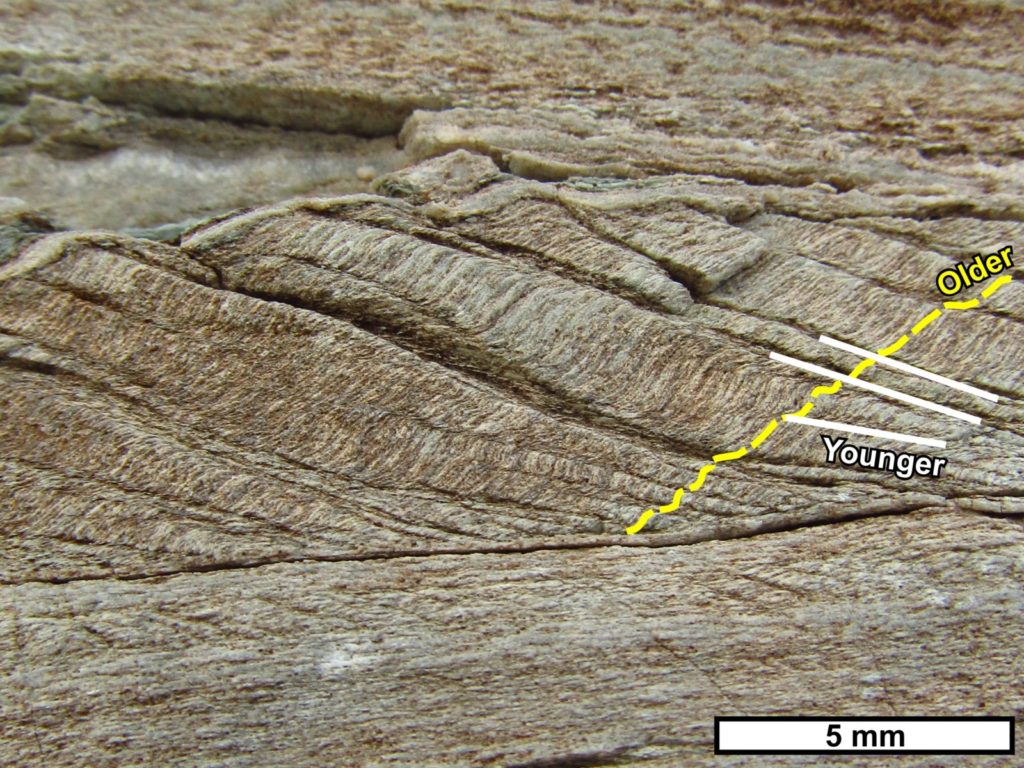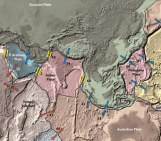
In one of the former episodes of the ‘Features from the field’ series we have talked about foliations, and how they develop when rocks are pushed together by the movement of tectonic plates. It is quite uncommon, however, that tectonic forces are active in the same direction for an unlimited period of time. The rule, rather than the exception, is that the orientation of tectonic forces (called stress field) changes continuously, as plates drift towards new directions, and mountain chains evolve through time. As a result, a foliation which developed earlier may be overprinted by a new foliation, with a brand new orientation, that refolds the previous structure. This second foliation is called ‘crenulation cleavage‘.

Schistose rocks with a nice continuous foliation. Note that the foliation is folded and, in places, an horizontal foliation developed. Le Chenaillet. Montgenevre, France. Photo © Samuele Papeschi
The photograph above shows well-foliated layers of schist and metasandstone. A continuous foliation goes from the upper-right to the lower-left corner and characterizes the structure of the rock. As you can see, this foliation is not straight, but it is affected by small folds that bend it with an amplitude of a few centimeters. Some of these folds are crosscut by a new, horizontal foliation that has the characteristic to be spaced (i.e. it is not pervasively developed) and also discontinuous (you can follow foliation planes just for a couple centimeters).

Detail: the older foliation is folded and the new foliation (crenulation cleavage) develops where planes are bent. Le Chenaillet, Montgenevre, France. Photo © Samuele Papeschi
In detail, the new foliation develops because the old foliation is bent. Mineral grains are rotated to become progressively parallel to the younger foliation, forming cleavage planes separated by ‘cleavage domains‘, where the older foliation is still recognizable. The rotation of old grains is not the only way rocks make a new foliation: in general, new mineral grains also start to grow in the younger cleavage plains, and circulating water-rich fluids may dissolve some material and deposit new one. If the process goes on, the transition between the folded foliation and the new cleavage planes becomes sharper and cleavage planes get progressively closer and more continuous.

Crenulation cleavage. Note the sharp transition between the folded (older) foliation and the planar, spaced (younger) foliation. Le Chenaillet, Montgenevre, France. Photo © Samuele Papeschi
You can already foresee where we are going to, isn’t it? If deformation continues, the older foliation becomes increasingly folded and transposed, while the younger foliation continues to grow in length and width. At the end of the process, you may develop a brand new continuous foliation, with little or no memory of pre-existing structures (see sketch below). This is a common problem when dealing with old rocks that may have experienced a long and complex deformation history but have lost memory of that. More or less preserved crenulation cleavages are one of the few hints that are left of that history. This is why it is extremely important to look at these structures in the field.

Progressive stages leading to the development of a crenulation cleavage in mudstones. Courtesy © Haakon Fossen
Further reading
Cosgrove, J. W., 1976. The formation of crenulation cleavage. Journal of the Geological Society 132, 155-178.
Swager, N., 1985. Solution transfer, mechanical rotation and kink-banded boundary migration during crenulation-cleavage development. Journal of Structural Geology 7, 421-429.
Worley, B., et al., 1997. Crenulation cleavage formation: evolving diffusion, deformation, and equilibration mechanisms with increasing metamorphic grade. Journal of Structural Geology 19, 1121-1135



